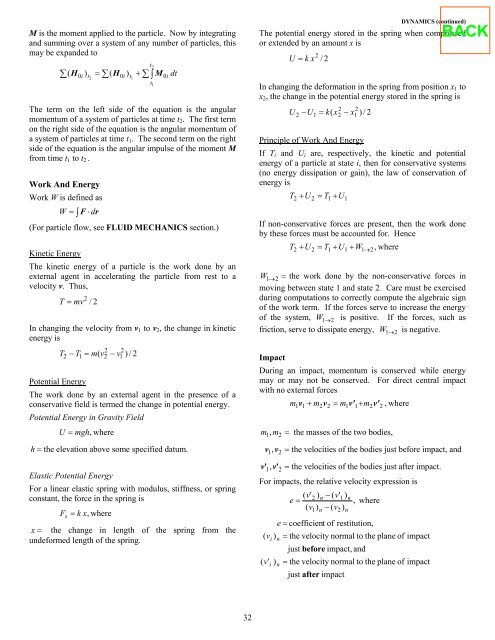fundamentals of engineering supplied-reference handbook - Ventech!
fundamentals of engineering supplied-reference handbook - Ventech!
fundamentals of engineering supplied-reference handbook - Ventech!
Create successful ePaper yourself
Turn your PDF publications into a flip-book with our unique Google optimized e-Paper software.
M is the moment applied to the particle. Now by integrating<br />
and summing over a system <strong>of</strong> any number <strong>of</strong> particles, this<br />
may be expanded to<br />
∑ ( H<br />
)<br />
0 i t<br />
2<br />
= ∑(<br />
H<br />
)<br />
0i<br />
t<br />
1<br />
t<br />
2<br />
+ ∑ ∫ M<br />
The term on the left side <strong>of</strong> the equation is the angular<br />
momentum <strong>of</strong> a system <strong>of</strong> particles at time t2. The first term<br />
on the right side <strong>of</strong> the equation is the angular momentum <strong>of</strong><br />
a system <strong>of</strong> particles at time t1. The second term on the right<br />
side <strong>of</strong> the equation is the angular impulse <strong>of</strong> the moment M<br />
from time t1 to t2 .<br />
Work And Energy<br />
Work W is defined as<br />
W = ∫ F ⋅ dr<br />
(For particle flow, see FLUID MECHANICS section.)<br />
Kinetic Energy<br />
The kinetic energy <strong>of</strong> a particle is the work done by an<br />
external agent in accelerating the particle from rest to a<br />
velocity v. Thus,<br />
2<br />
T = mv /2<br />
In changing the velocity from v1 to v2, the change in kinetic<br />
energy is<br />
2 2<br />
2 − 1 = 2 − 1<br />
T T m( v v )/2<br />
Potential Energy<br />
The work done by an external agent in the presence <strong>of</strong> a<br />
conservative field is termed the change in potential energy.<br />
Potential Energy in Gravity Field<br />
U = mgh,<br />
where<br />
t<br />
1<br />
0i<br />
h = the elevation above some specified datum.<br />
Elastic Potential Energy<br />
For a linear elastic spring with modulus, stiffness, or spring<br />
constant, the force in the spring is<br />
Fs = k x,<br />
where<br />
x = the change in length <strong>of</strong> the spring from the<br />
undeformed length <strong>of</strong> the spring.<br />
dt<br />
32<br />
DYNAMICS (continued)<br />
The potential energy stored in the spring when compressed<br />
or extended by an amount x is<br />
2<br />
U = k x / 2<br />
In changing the deformation in the spring from position x1 to<br />
x2, the change in the potential energy stored in the spring is<br />
2<br />
2<br />
U − U = k(<br />
x − x<br />
2<br />
1<br />
2<br />
1<br />
) / 2<br />
Principle <strong>of</strong> Work And Energy<br />
If Ti and Ui are, respectively, the kinetic and potential<br />
energy <strong>of</strong> a particle at state i, then for conservative systems<br />
(no energy dissipation or gain), the law <strong>of</strong> conservation <strong>of</strong><br />
energy is<br />
T + U = T + U<br />
2<br />
2<br />
1<br />
1<br />
If non-conservative forces are present, then the work done<br />
by these forces must be accounted for. Hence<br />
T + U = T + U + W , where<br />
2 2 1 1 1→2<br />
W1→ 2 = the work done by the non-conservative forces in<br />
moving between state 1 and state 2. Care must be exercised<br />
during computations to correctly compute the algebraic sign<br />
<strong>of</strong> the work term. If the forces serve to increase the energy<br />
<strong>of</strong> the system, W 1→2<br />
is positive. If the forces, such as<br />
friction, serve to dissipate energy, W 1→2<br />
is negative.<br />
Impact<br />
During an impact, momentum is conserved while energy<br />
may or may not be conserved. For direct central impact<br />
with no external forces<br />
m v + m v = m v' + m v' , where<br />
1 2<br />
1 2<br />
1 1<br />
2<br />
m , m = the masses <strong>of</strong> the two bodies,<br />
2<br />
1<br />
1<br />
v , v = the velocities <strong>of</strong> the bodies just before impact, and<br />
v'1, v'2<br />
= the velocities <strong>of</strong> the bodies just after impact.<br />
For impacts, the relative velocity expression is<br />
( v'2<br />
) n − ( v'1<br />
) n<br />
e =<br />
, where<br />
( v ) − ( v )<br />
1<br />
n<br />
2<br />
n<br />
e<br />
= coefficient<br />
<strong>of</strong> restitution,<br />
( vi<br />
) n = the velocity normal to the plane <strong>of</strong> impact<br />
just before impact, and<br />
( v'i<br />
) n = the velocity normal to the plane <strong>of</strong> impact<br />
just after impact<br />
2<br />
2
















